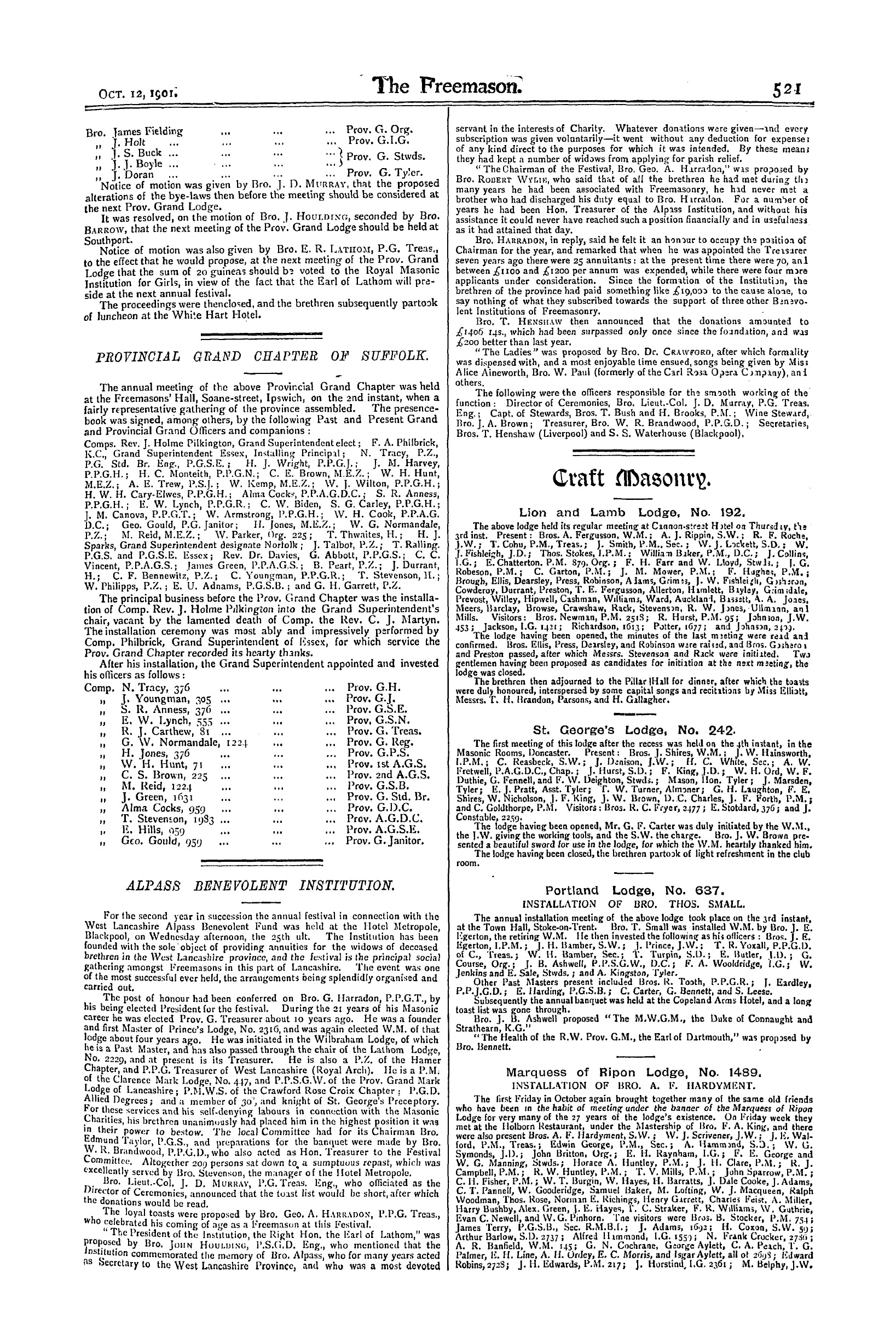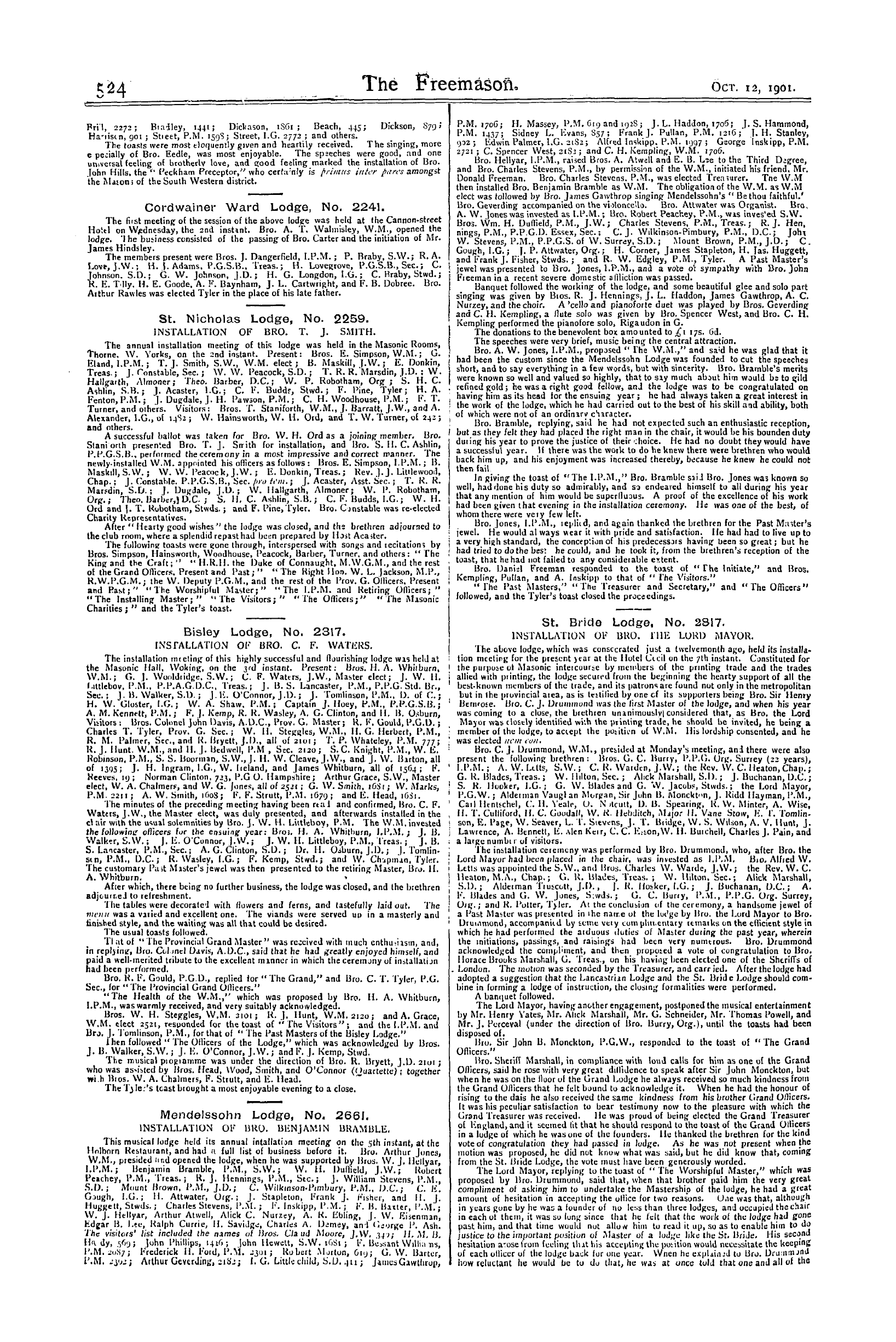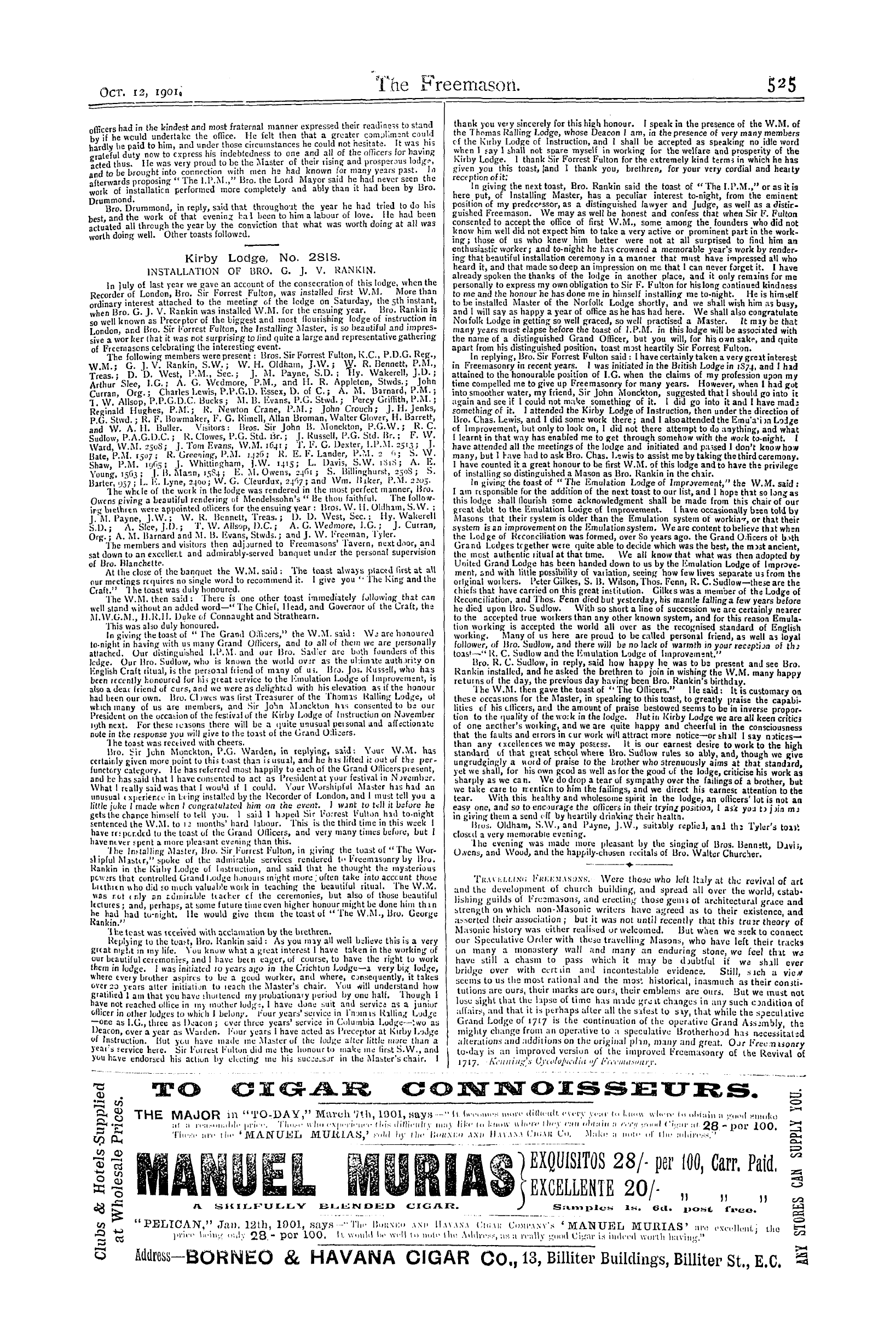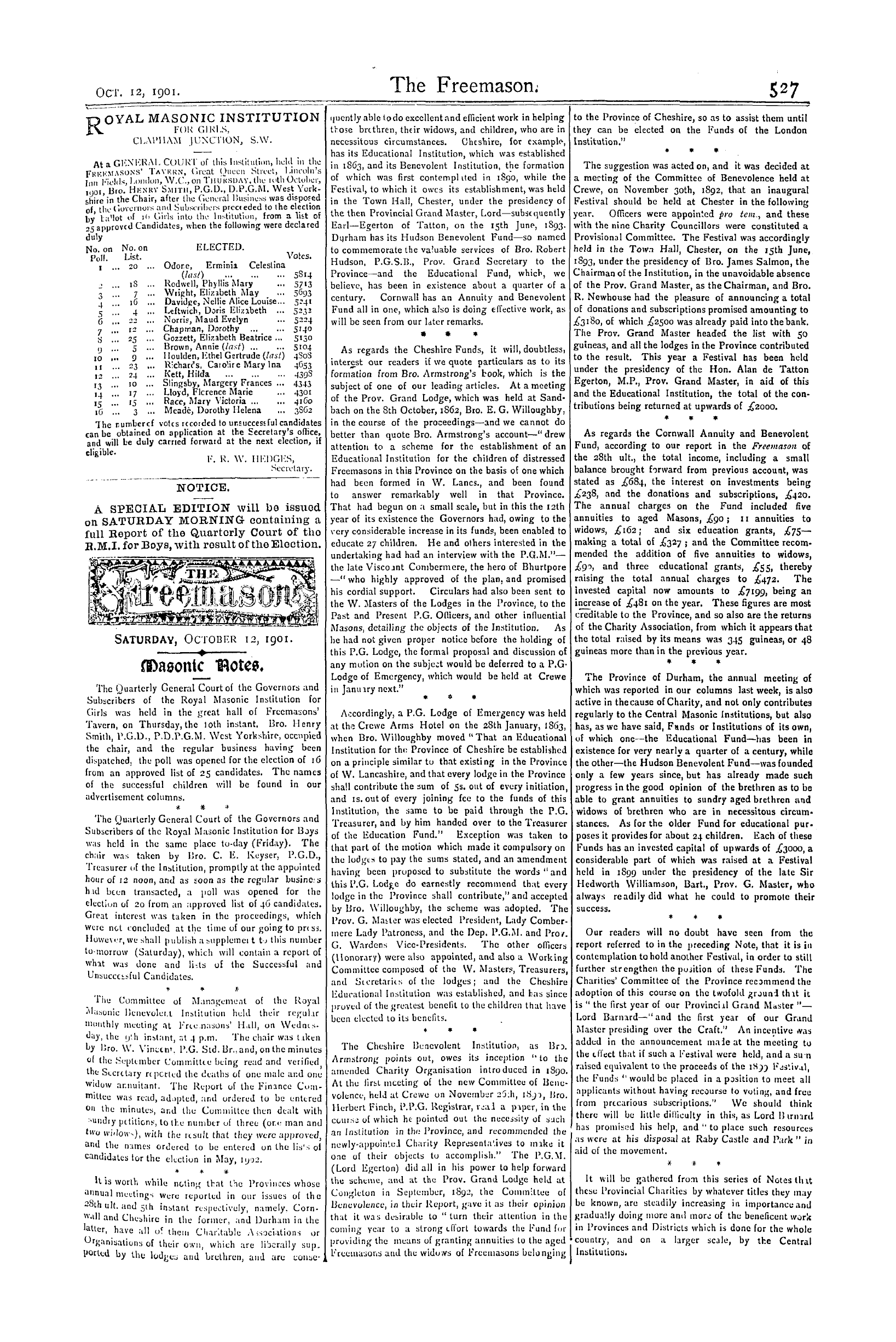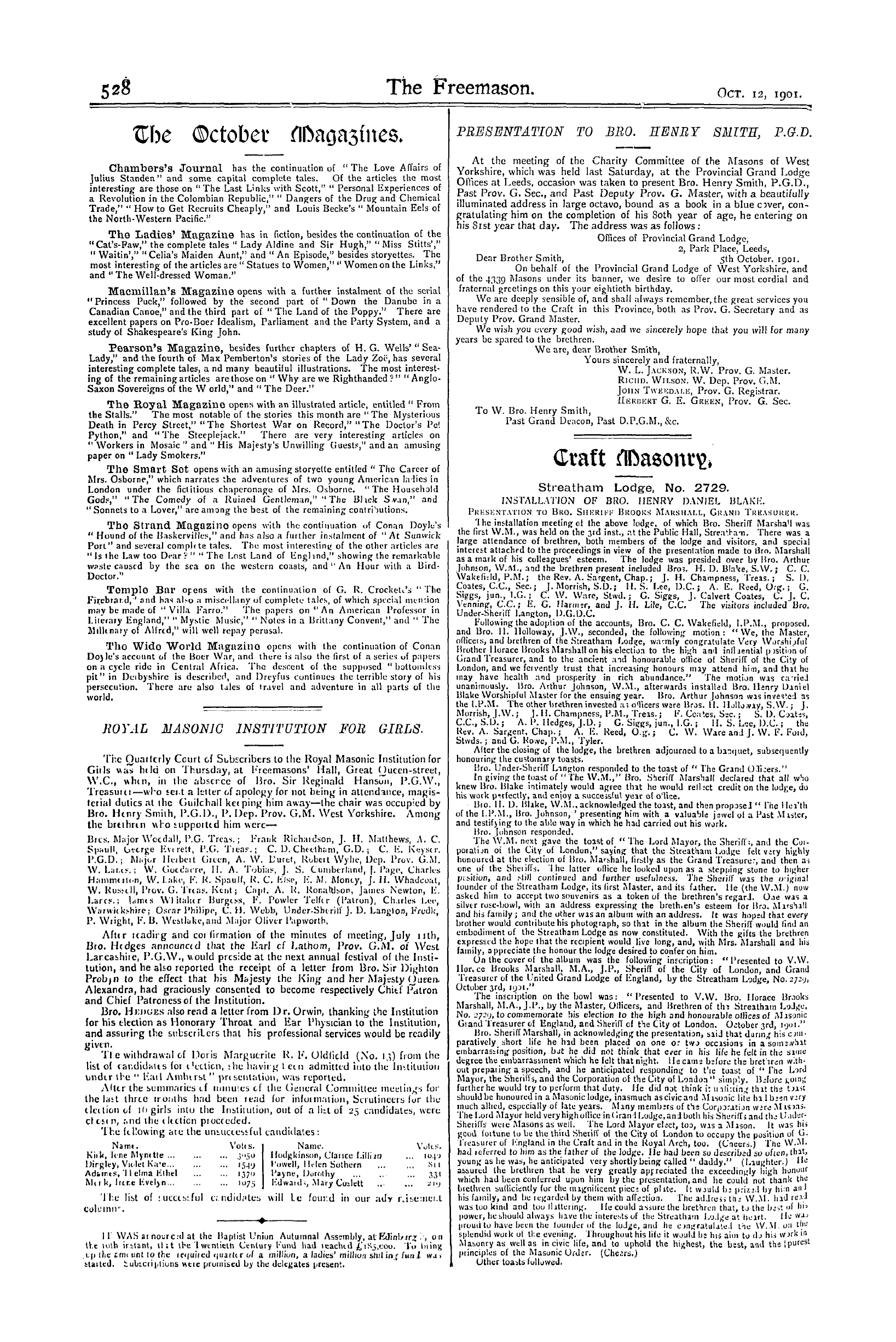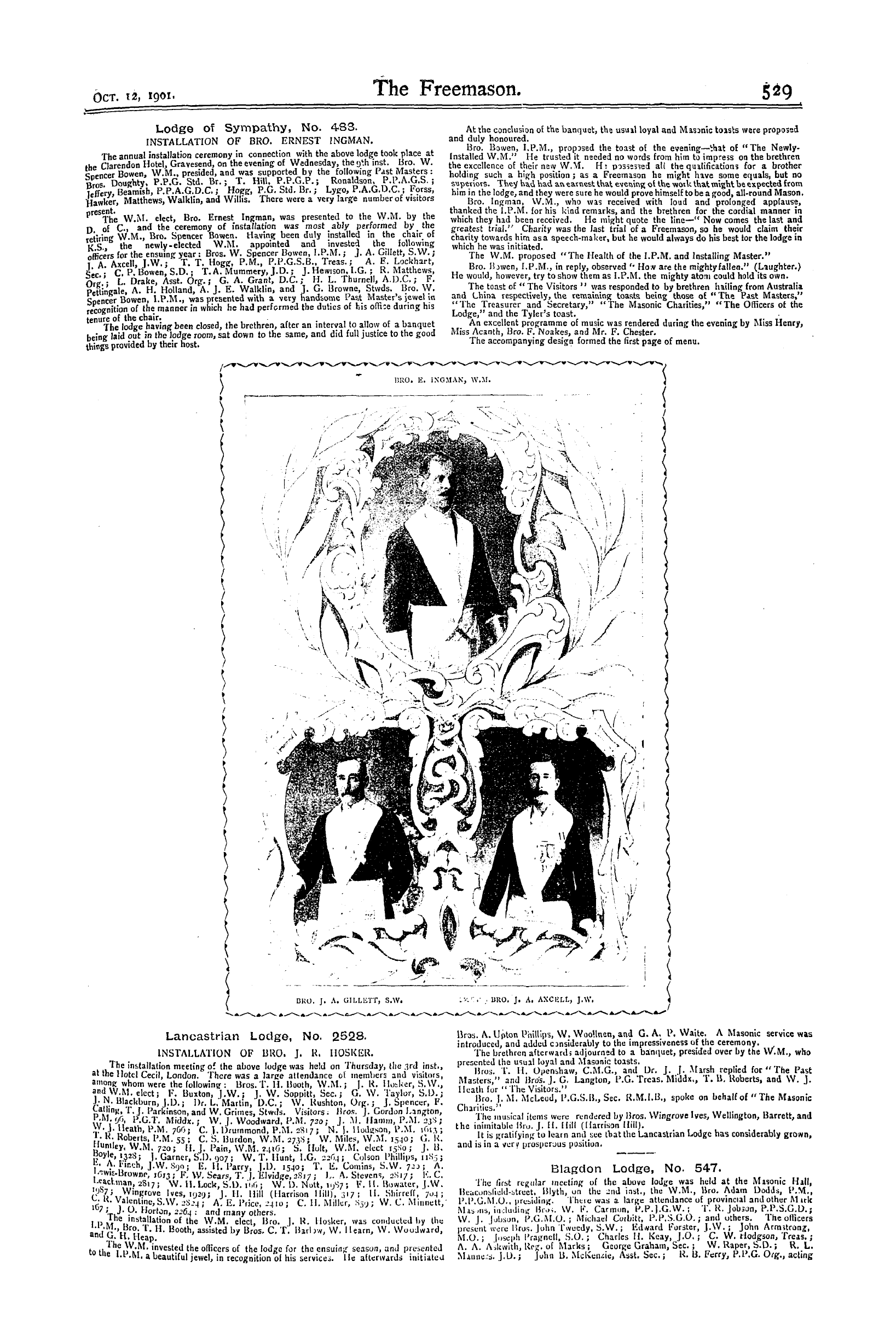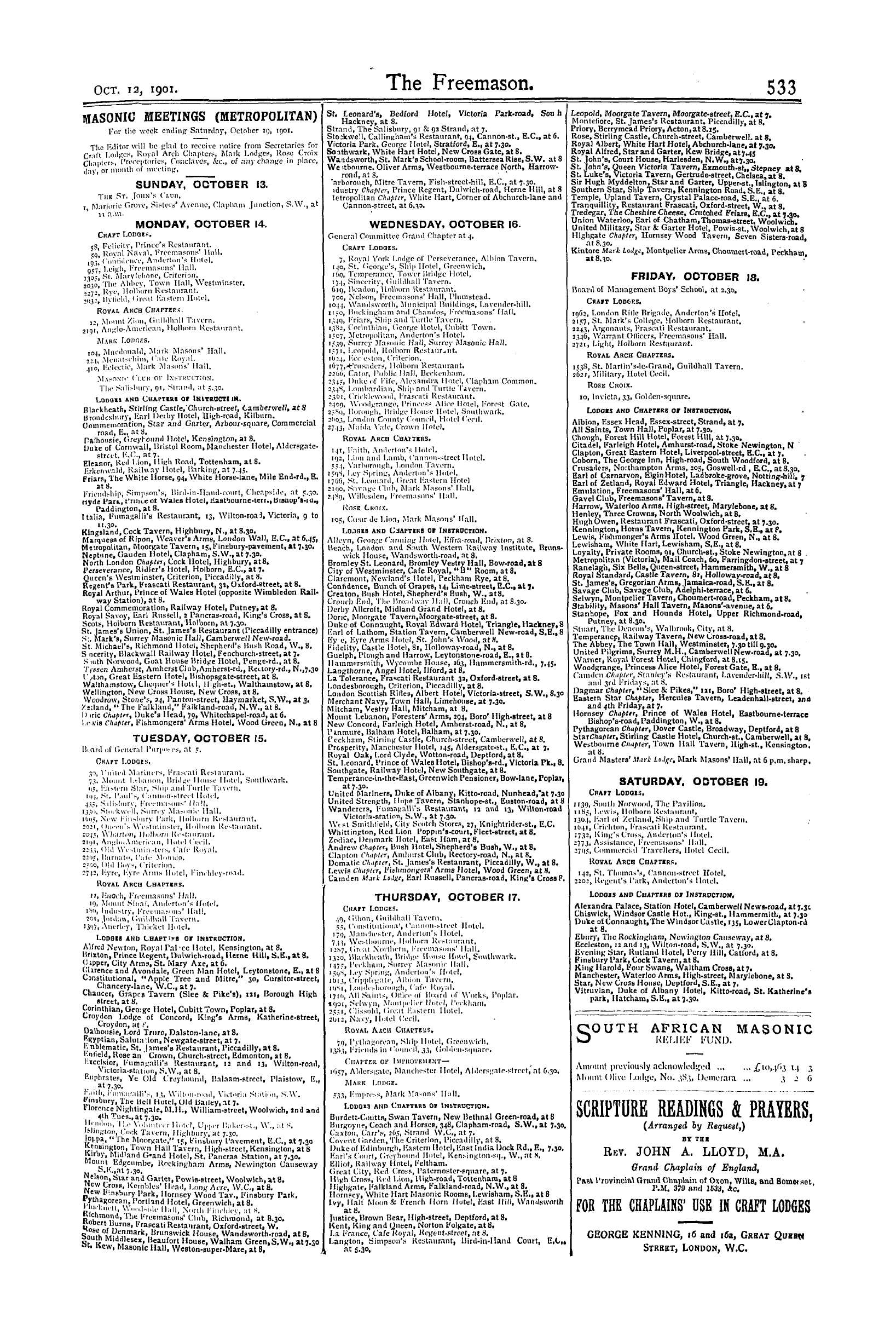-
Articles/Ads
Article Science, Art, and the Drama. Page 1 of 1 Article Science, Art, and the Drama. Page 1 of 1
Note: This text has been automatically extracted via Optical Character Recognition (OCR) software.
Science, Art, And The Drama.
Science , Art , and the Drama .
FALSE GEMS . That many things glitter which are not gold is well known ; but do the wearers of jewellery know that the bright and beautiful colours exhibited by most of their much prized gems are purely artificial ? Nature supplies the raw material , and art steps in to embellish it . The brilliant necklace or bracelet , which , with the native hue of the stone , would , by no means , be considered ornamental , becomes matchless in tint and lustre after passing
through the hands of the artificer . The chemist , always discovering something , and always ready with marvellous transformations , is truly a remarkable personage . He is jealous of his secrets ; but not always able to keep them . If he could set a seal on his doings , the world would not become acquainted with some of his processes . Let us take the agate , rather a common stone , found almost everywhere , and in numerous varieties , among
which are the chalcedony , cornelian , onyx , sardonyx , and heliotrope . They all consist principally of quartz , and are more or less psllucid . In some places they are surprisingly abundant . One of these places is Oberstein , same 30 or 40 miles up the valley of the Nahe , a region not often visited by summer tourists , yet interesting enough to repay him who shall explore its devious by-ways and paths along the river . At the village just mentioned
and at Idal , four miles distant , formations of coarse red conglomerate are met with , interposed with trap and greenstone , and in a soft stratum in these rocks , agates are found in considerable quantities . The workings may , indeed , be called agate-quarries , for they are carried on in the precipitous side of a hill , and to him who sees them for the first tirae there is something remarkable in the species of industry , created by tha
presence of the stones . The nodules of agate , as they come from their long undisturbed bed , are generally of an ashen-grey colour . The first operation in the process of transformation is to wash them perfectly clean ; then to put them into a vessel containing a mixture of honey and water , which , being closely covered , is plunged into hot ashes for two or three weeks . The essential thing is to keep the liquid from boiling , but ' at a high
temperature . After a sufficient interval , the stones are taken out , cleansed , passed through a bath of sulphuric acid , and then they undergo a second course of roasting in the hot ashes . To produce a colour in the stones , it is necessary they should be penetrated by some carbonisable substance . Tnis is effected by the honey , which , under the infliience of long-continued heat , finds its way into the interior of the crystal , where its carbonisation , if not
complete in the first instance , is finished by the sulphuric acid . Some lapidaries use olive-oil instead of honey . The shade of colour depends on the porosity of the layers of the stone ; the most porous become , at times , perfectly black . Some are coloured in two or three ho irs , others in as many days , others in a week or two , and some resist all attempts to change their natural hue . Some , when taken out of the pan , are found to be a
rich dark brown or chocolate ; others , again , having been penetrated by tha colouring matter between the layers , are striped alternately white , grey , and brown , like the onyx and sardonyx . I 3 y soiking the stones in a solution of sulphate of iron , and then placing them for a few hours in the oven , a fine cornelian-red is produced in the porous layers , while those not porous remain unaltered . Thus it not unfrequently happens that very coarse and common
stones—muddy yellow or cloudy grey—which in their natural condition would be valueless , are passed off as stones of the first quality . It is only within the last 40 years that this process has been known in Germany ; but the Italian lapidaries were acquainted with it centuries ago . Hence we can account for the exquisite colour of antique cameos and other ornaments once numerous in the cabinets of Italy , and now to be seen in
museums and private collections in all parts of the world . I he dealers , when making their purchases of what we may call the raw material , select what appears to be a desirable piece , and chipping oil a minute portion , they moisten the exposed surface with the tongue , and watch the absorption of the moisture . If regular and equal , the stone is good for an onyx ; if not , it is added to the heap of inferior varieties . This , however , is but a
rough-and-ready test , and not always decisive . The pores of the stones by which the colour is conveyed and retained are visible with the microscope , and the effect of various tints is produced according as the light falls upon Ihem at different angles . The rainbow-agate is full of minuts cells , which when exposed to the sun , produce prismatic colours , as is observed of the strife of mother-of-pearl . To detect cavities in the stones they arc soaked
in water , which , slowly penetrating , reveals the hollows . Some already contain water when first found ; and it is a remarkable fact that , if kept in a dry place , the water disappears , but without leaving the slightest trace of moisture on the surface , and the stones can only be refilled by boiling them . Balls of striped red chalcedony are much prized ; a large one , weighing 100 lbs ., was found in 1844 near Weisselberg , and was sold in
the rough for 700 guilders . Some kinds of chalcedony are made to appear of a citron yellow by a two days' roasting in an oven , and a subsequent immersion in a close hot bath of spirit of salt for two or three weeks . A blue colour , which has all the effect of a turquoise , is also produced , but the particular colouring process has hitherto been kept a secret . Those stones which are naturally coloured are , at times , roasted , to heighten the
tint and add to its permanency . The Brazilian cornelian becomes singularly lustrous under the process . The smallest stones are roasted before polishing , but the large ones , of which saucers , vases , cups , plates , ccc , are made , are first cut into the required shape and thinness—otherwise they fly to pieces when exposed to heat . After all the colouring operations have been gone through , the stones are ground on a wheel , soaked in oil for a day to
conceal the fine scratches and give a good polish , and then cleaned off with bran . We now come to gems that are nut found in the side of a quarry , but formed in a chemist ' s laboratory . The chemist in his work produces wonderful results . He produces crystals at pleasure , and in lumps that would astonish those who once laboured so hard in search of the philosopher's stone . Some years ago , M . Ebelman laid before the French
Academy of Sciences , specimens of artificial quartz—some while , others blue , red , and violet—and by mixing chloruret of gold with \\\ K silkic acid used in the composition , he produced a mass traversed throughout with delicate veins of gold , similar to the lumps brought from Australia or California—he also produced hydrophane—a species of opal which is transparent only when immersed in water ; and specimens also of the allied crystal hyalite . ( To be con tinned . J
Science, Art, And The Drama.
THE PAINTER VANDERDORT—TEMP . CHARLES I . Having mentioned Vanderdort , in connexion with the King ' s catalogue it will be as well to give some account of him . Abraham Vanderdort , a Dutchman , had worked for the Emperor Rodolphus , whose service he left , it is not known on what occasion . He brought away with him a bust of a woman modelled in wax , as large as life , which he had begun for that monarch , but Prince Henry was so struck with it , that though the Emperor wrote several times for it , the young Prince would neither part with the
work nor the workman , telling him he would give him as good entertainment as any emperor would ; and , indeed , Vanderdort seems to have made no bad bargain . He parted with the bust to the Prince , upon condition , that as soon as the cabinet , then building from ' a design of Inigo Jones should be finished , he should be made keeper of his Royal Highness ' s medals with a salary of £ 50 a year ; a contract voided by the death of the Prince '
However , upon the accession of King Charles , Vanderdort was immediatel y retained in his service , with a salary of j £ 40 a year , and appointed keeper of the cabinet . This room was erected about the middle of Whitehall running across from the Thames towards the banqueting-house and fronting westward to the privy garden . Several warrants for payment to Vanderdort are extant in Rymer and among the Conway papers ; one of
tne latter is singular indeed , and shows in what favour he stood with his royal master : " The 2 nd day of April , 1625 , at St . James . His Majesty was pleased by my Lord Duke of Buckingham ' s means to send for Sir Edward Villiers , warden of his Majesties mint , as also for his owne servant Abraham Vanderdoort , where his Majesty did command in the presence of the said Lord Duke and Sir Edward Villiers , that the said Abraham
Vanderdoort should make patterns for his Majesties coynes , and also give his assistance to the ingravers , and his furtherance that the same may be well engraven , according to their abilities . For which he desireth a warrant with an annual fee of , £ 40 a year , whereby it may appear that it was his Majesties pleasure to appoint him for that service . " ( Conwav Papers . ) At
the bottom of this paper is this entry : " It is his Majesty ' s pleasure that the clerk of his Majesties signett , for the tyme being , doe cause a booke to be prepared litt for his Majesties signature of the office , with the anniutie or fee , beforcmentioned , to be paid out of the exchequer duringe his life . " The patent gave him likewise the privilege of being the king ' s medallist , " in gold , silver , brasse , " Sec .
THE ROYAL SOCIETY PAINTERS IN WATER COLOURS ,
SA , PALL MALL EAST , S . W . SPECIAL EXHIBITION' OF THE WORKS OF THE LATE WM . STOTT , OF OLDHAM . We have visited this collection . The artist has a style of his own , " non captandum vulgus . " Some of his pictures evince careful study , and are worthy of attention . Deep poetical feeling is shown in many of his works
—not to be recognised by a mere casual glance . Among his pictures we notice Nos . 2 , "The Awakening of the Spirit of the Rose , " delicately treated ; 13 . " The White Mountain , " fine Alpine scene ; 14 , Idlers ; nj , Portrait of T . Millie Dow , life like ; 21 , Eiger , a noble picture ; 24 , Tristram's Farewell , fine colour , artistically treated ; 26 , Barn at Gasgarth ;
30 , The Irish Channel , good seascape ; 37 , The Happy Valley , a beautiful poetical conception ; 44 , Morning in the Alps , another mountain scene ; 45 , Waterfall , the rushing torrent well depicted ; 47 , Hide-and-Seek ; In the Garden of Epicurus , a notable instance of the artist ' s original style .
FHE CRITERION THEATRE
We have all of us , on many occasions , derived so much pleasure from the ingenious and well-constructed plots of Mr . R . C . Carton that we must confess to a feeling of disappointment at the dramatist ' s new four-act comedy , " The Undercurrent , " now playing at the Criterion . There is much brilliant writing , as we might naturally expect , but the story is hardly intelligible , and is of so hazy a nature that , at it > conclusion , it would be
difficult to give a complete summary . The title of the piece is open to two or three meanings ; we imagine that the gifted author by " The Undercurrent" means the inlluence of fair woman on all the relations of life , whether for good or ill . The artists exert their utmost to develop their respective parts . We would notice ( place aux dames ) the clever acting of Miss Compton , the " Dea ex machina" of the piece ; Miss Anna Robinson as the American heiress . Among the actors we had Mr . Arthur Bourchier ,
who has little opportunity of displaying his talent ; Messrs . Arthur Williams and Ernest Hcndric showed some skill in bringing out the comic phase of tlieir respective parts . Great gaps in the main plot , such as it is , arc filled up with a rehearsal of private theatricals , given by the castle guests . We were reminded of the well-known piece '' The Pantomime Rehearsal , " but it fails in its witty dialogue and action . We regret to say that the piece had only " uu sttcces d ' cstiine . "
GENERAL NOTES . At the Playgoers' Club , Clement ' s Inn , an informal debate on the piece " Becky Sharpe " ( at present running so successful a career at the Prince of Wales Theatre ) took place last Thursday . The discussion was opened by Mr . F . S . Hess . » * * » " Les Papillons " still deservedly continues an attractive feature of the Empire programme . Nothing more beautiful or more truly fairylike has been seen on the stage for many . 1 long day .
Miss Julia Neilson , Mr . Fred Terry , and the entire Globe Theatre , paid a welcome return visit to Kennington Theatre last week with " Sweet Nell of Old Drury . "
I 1 RO . KARL ROBERTS , on the ioth inst ., unveiled a memorial statue of Queen Victoiia , thc work of Mr . Onslow Ford , in front of the Royal Inlirmary , Manchester . His lonbhip said he could nit help thinking lhat but for the intense anxiety caused by the South African war her Majesty might still have been with us . When he took Ins leave of our late Sovereign , in December , iS . jy , she seemed to be in as good health as lie bad seen her in for several years , but on his leturn to Kngland he was startled by the change that had taken place in her appearance . The Commander-in-Chief went on to reler to the keen interest taken by Queen Victoria in thc Army , the Navy , and the welfare of her whole people .
Note: This text has been automatically extracted via Optical Character Recognition (OCR) software.
Science, Art, And The Drama.
Science , Art , and the Drama .
FALSE GEMS . That many things glitter which are not gold is well known ; but do the wearers of jewellery know that the bright and beautiful colours exhibited by most of their much prized gems are purely artificial ? Nature supplies the raw material , and art steps in to embellish it . The brilliant necklace or bracelet , which , with the native hue of the stone , would , by no means , be considered ornamental , becomes matchless in tint and lustre after passing
through the hands of the artificer . The chemist , always discovering something , and always ready with marvellous transformations , is truly a remarkable personage . He is jealous of his secrets ; but not always able to keep them . If he could set a seal on his doings , the world would not become acquainted with some of his processes . Let us take the agate , rather a common stone , found almost everywhere , and in numerous varieties , among
which are the chalcedony , cornelian , onyx , sardonyx , and heliotrope . They all consist principally of quartz , and are more or less psllucid . In some places they are surprisingly abundant . One of these places is Oberstein , same 30 or 40 miles up the valley of the Nahe , a region not often visited by summer tourists , yet interesting enough to repay him who shall explore its devious by-ways and paths along the river . At the village just mentioned
and at Idal , four miles distant , formations of coarse red conglomerate are met with , interposed with trap and greenstone , and in a soft stratum in these rocks , agates are found in considerable quantities . The workings may , indeed , be called agate-quarries , for they are carried on in the precipitous side of a hill , and to him who sees them for the first tirae there is something remarkable in the species of industry , created by tha
presence of the stones . The nodules of agate , as they come from their long undisturbed bed , are generally of an ashen-grey colour . The first operation in the process of transformation is to wash them perfectly clean ; then to put them into a vessel containing a mixture of honey and water , which , being closely covered , is plunged into hot ashes for two or three weeks . The essential thing is to keep the liquid from boiling , but ' at a high
temperature . After a sufficient interval , the stones are taken out , cleansed , passed through a bath of sulphuric acid , and then they undergo a second course of roasting in the hot ashes . To produce a colour in the stones , it is necessary they should be penetrated by some carbonisable substance . Tnis is effected by the honey , which , under the infliience of long-continued heat , finds its way into the interior of the crystal , where its carbonisation , if not
complete in the first instance , is finished by the sulphuric acid . Some lapidaries use olive-oil instead of honey . The shade of colour depends on the porosity of the layers of the stone ; the most porous become , at times , perfectly black . Some are coloured in two or three ho irs , others in as many days , others in a week or two , and some resist all attempts to change their natural hue . Some , when taken out of the pan , are found to be a
rich dark brown or chocolate ; others , again , having been penetrated by tha colouring matter between the layers , are striped alternately white , grey , and brown , like the onyx and sardonyx . I 3 y soiking the stones in a solution of sulphate of iron , and then placing them for a few hours in the oven , a fine cornelian-red is produced in the porous layers , while those not porous remain unaltered . Thus it not unfrequently happens that very coarse and common
stones—muddy yellow or cloudy grey—which in their natural condition would be valueless , are passed off as stones of the first quality . It is only within the last 40 years that this process has been known in Germany ; but the Italian lapidaries were acquainted with it centuries ago . Hence we can account for the exquisite colour of antique cameos and other ornaments once numerous in the cabinets of Italy , and now to be seen in
museums and private collections in all parts of the world . I he dealers , when making their purchases of what we may call the raw material , select what appears to be a desirable piece , and chipping oil a minute portion , they moisten the exposed surface with the tongue , and watch the absorption of the moisture . If regular and equal , the stone is good for an onyx ; if not , it is added to the heap of inferior varieties . This , however , is but a
rough-and-ready test , and not always decisive . The pores of the stones by which the colour is conveyed and retained are visible with the microscope , and the effect of various tints is produced according as the light falls upon Ihem at different angles . The rainbow-agate is full of minuts cells , which when exposed to the sun , produce prismatic colours , as is observed of the strife of mother-of-pearl . To detect cavities in the stones they arc soaked
in water , which , slowly penetrating , reveals the hollows . Some already contain water when first found ; and it is a remarkable fact that , if kept in a dry place , the water disappears , but without leaving the slightest trace of moisture on the surface , and the stones can only be refilled by boiling them . Balls of striped red chalcedony are much prized ; a large one , weighing 100 lbs ., was found in 1844 near Weisselberg , and was sold in
the rough for 700 guilders . Some kinds of chalcedony are made to appear of a citron yellow by a two days' roasting in an oven , and a subsequent immersion in a close hot bath of spirit of salt for two or three weeks . A blue colour , which has all the effect of a turquoise , is also produced , but the particular colouring process has hitherto been kept a secret . Those stones which are naturally coloured are , at times , roasted , to heighten the
tint and add to its permanency . The Brazilian cornelian becomes singularly lustrous under the process . The smallest stones are roasted before polishing , but the large ones , of which saucers , vases , cups , plates , ccc , are made , are first cut into the required shape and thinness—otherwise they fly to pieces when exposed to heat . After all the colouring operations have been gone through , the stones are ground on a wheel , soaked in oil for a day to
conceal the fine scratches and give a good polish , and then cleaned off with bran . We now come to gems that are nut found in the side of a quarry , but formed in a chemist ' s laboratory . The chemist in his work produces wonderful results . He produces crystals at pleasure , and in lumps that would astonish those who once laboured so hard in search of the philosopher's stone . Some years ago , M . Ebelman laid before the French
Academy of Sciences , specimens of artificial quartz—some while , others blue , red , and violet—and by mixing chloruret of gold with \\\ K silkic acid used in the composition , he produced a mass traversed throughout with delicate veins of gold , similar to the lumps brought from Australia or California—he also produced hydrophane—a species of opal which is transparent only when immersed in water ; and specimens also of the allied crystal hyalite . ( To be con tinned . J
Science, Art, And The Drama.
THE PAINTER VANDERDORT—TEMP . CHARLES I . Having mentioned Vanderdort , in connexion with the King ' s catalogue it will be as well to give some account of him . Abraham Vanderdort , a Dutchman , had worked for the Emperor Rodolphus , whose service he left , it is not known on what occasion . He brought away with him a bust of a woman modelled in wax , as large as life , which he had begun for that monarch , but Prince Henry was so struck with it , that though the Emperor wrote several times for it , the young Prince would neither part with the
work nor the workman , telling him he would give him as good entertainment as any emperor would ; and , indeed , Vanderdort seems to have made no bad bargain . He parted with the bust to the Prince , upon condition , that as soon as the cabinet , then building from ' a design of Inigo Jones should be finished , he should be made keeper of his Royal Highness ' s medals with a salary of £ 50 a year ; a contract voided by the death of the Prince '
However , upon the accession of King Charles , Vanderdort was immediatel y retained in his service , with a salary of j £ 40 a year , and appointed keeper of the cabinet . This room was erected about the middle of Whitehall running across from the Thames towards the banqueting-house and fronting westward to the privy garden . Several warrants for payment to Vanderdort are extant in Rymer and among the Conway papers ; one of
tne latter is singular indeed , and shows in what favour he stood with his royal master : " The 2 nd day of April , 1625 , at St . James . His Majesty was pleased by my Lord Duke of Buckingham ' s means to send for Sir Edward Villiers , warden of his Majesties mint , as also for his owne servant Abraham Vanderdoort , where his Majesty did command in the presence of the said Lord Duke and Sir Edward Villiers , that the said Abraham
Vanderdoort should make patterns for his Majesties coynes , and also give his assistance to the ingravers , and his furtherance that the same may be well engraven , according to their abilities . For which he desireth a warrant with an annual fee of , £ 40 a year , whereby it may appear that it was his Majesties pleasure to appoint him for that service . " ( Conwav Papers . ) At
the bottom of this paper is this entry : " It is his Majesty ' s pleasure that the clerk of his Majesties signett , for the tyme being , doe cause a booke to be prepared litt for his Majesties signature of the office , with the anniutie or fee , beforcmentioned , to be paid out of the exchequer duringe his life . " The patent gave him likewise the privilege of being the king ' s medallist , " in gold , silver , brasse , " Sec .
THE ROYAL SOCIETY PAINTERS IN WATER COLOURS ,
SA , PALL MALL EAST , S . W . SPECIAL EXHIBITION' OF THE WORKS OF THE LATE WM . STOTT , OF OLDHAM . We have visited this collection . The artist has a style of his own , " non captandum vulgus . " Some of his pictures evince careful study , and are worthy of attention . Deep poetical feeling is shown in many of his works
—not to be recognised by a mere casual glance . Among his pictures we notice Nos . 2 , "The Awakening of the Spirit of the Rose , " delicately treated ; 13 . " The White Mountain , " fine Alpine scene ; 14 , Idlers ; nj , Portrait of T . Millie Dow , life like ; 21 , Eiger , a noble picture ; 24 , Tristram's Farewell , fine colour , artistically treated ; 26 , Barn at Gasgarth ;
30 , The Irish Channel , good seascape ; 37 , The Happy Valley , a beautiful poetical conception ; 44 , Morning in the Alps , another mountain scene ; 45 , Waterfall , the rushing torrent well depicted ; 47 , Hide-and-Seek ; In the Garden of Epicurus , a notable instance of the artist ' s original style .
FHE CRITERION THEATRE
We have all of us , on many occasions , derived so much pleasure from the ingenious and well-constructed plots of Mr . R . C . Carton that we must confess to a feeling of disappointment at the dramatist ' s new four-act comedy , " The Undercurrent , " now playing at the Criterion . There is much brilliant writing , as we might naturally expect , but the story is hardly intelligible , and is of so hazy a nature that , at it > conclusion , it would be
difficult to give a complete summary . The title of the piece is open to two or three meanings ; we imagine that the gifted author by " The Undercurrent" means the inlluence of fair woman on all the relations of life , whether for good or ill . The artists exert their utmost to develop their respective parts . We would notice ( place aux dames ) the clever acting of Miss Compton , the " Dea ex machina" of the piece ; Miss Anna Robinson as the American heiress . Among the actors we had Mr . Arthur Bourchier ,
who has little opportunity of displaying his talent ; Messrs . Arthur Williams and Ernest Hcndric showed some skill in bringing out the comic phase of tlieir respective parts . Great gaps in the main plot , such as it is , arc filled up with a rehearsal of private theatricals , given by the castle guests . We were reminded of the well-known piece '' The Pantomime Rehearsal , " but it fails in its witty dialogue and action . We regret to say that the piece had only " uu sttcces d ' cstiine . "
GENERAL NOTES . At the Playgoers' Club , Clement ' s Inn , an informal debate on the piece " Becky Sharpe " ( at present running so successful a career at the Prince of Wales Theatre ) took place last Thursday . The discussion was opened by Mr . F . S . Hess . » * * » " Les Papillons " still deservedly continues an attractive feature of the Empire programme . Nothing more beautiful or more truly fairylike has been seen on the stage for many . 1 long day .
Miss Julia Neilson , Mr . Fred Terry , and the entire Globe Theatre , paid a welcome return visit to Kennington Theatre last week with " Sweet Nell of Old Drury . "
I 1 RO . KARL ROBERTS , on the ioth inst ., unveiled a memorial statue of Queen Victoiia , thc work of Mr . Onslow Ford , in front of the Royal Inlirmary , Manchester . His lonbhip said he could nit help thinking lhat but for the intense anxiety caused by the South African war her Majesty might still have been with us . When he took Ins leave of our late Sovereign , in December , iS . jy , she seemed to be in as good health as lie bad seen her in for several years , but on his leturn to Kngland he was startled by the change that had taken place in her appearance . The Commander-in-Chief went on to reler to the keen interest taken by Queen Victoria in thc Army , the Navy , and the welfare of her whole people .


